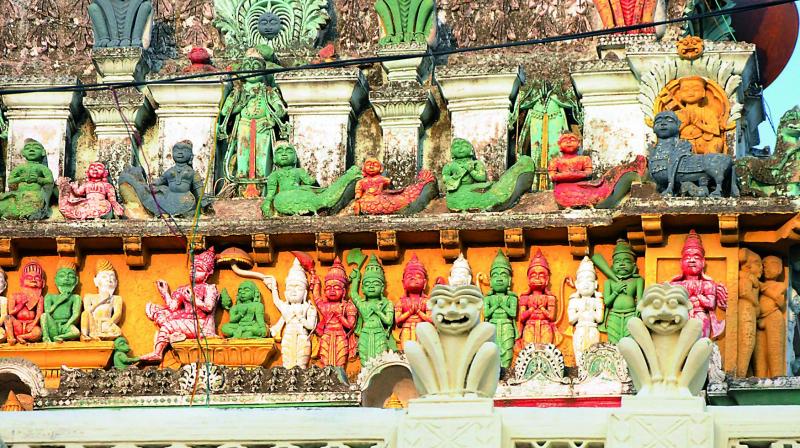A unique confluence of equine art & Rajput valour
Jham Singh Venkateshwara temple is a blend of many arts in itself.

Hyderabad: The huge ground is filled with groups of cricket players and balls fly hither and thither. In one corner is the forgotten but beautiful Jham Singh Sri Venkateswara Swamy temple and as the name signifies, it was built by a Rajasthani.
The entrance is very dirty but inside it is a riot of fading colours and images of birds, flora and fauna and the local culture. Peacocks abound, beautiful jharokhas reiterate the Rajasthani influence.
While the gopuram of the temple is traditional, the temple itself is a combination of Rajasthani, Qutub Shahi and local architecture. There are also some fruits carved into the structure, bringing a European touch. In fact there is an old Qutub Shahi mosque behind the temple, now gone to seed.
Jham Singh was a cavalier in the Army of Nawab Sikander Jah Nizam III, the ruler of Hyderabad State from 1803-1829 AD. He was from Unnao, a district in Uttar Pradesh and came to Hyderabad State when he was appointed commandant. Jham Singh was an equine expert and purchased horses for the Nizam and his army.
Jham Singh had other interests which included building a temple. He had seen the mosques and palaces of the Nawabs and thought of building a temple. Thus the Balaji-Venkateshwara Swamy temple came into existence around 1810.
Another legend has it that he was directed in a dream to build a temple. The Nizam was angry about the construction of the temple and initiated penal action against Jham Singh. But fortunately for Jham Singh, Raja Chandu Lal, the then Hindu Prime Minister, intervened. The kindly Sikander Jah relented and instead of putting the horse trader in the dungeon, ordered that Jham Singh build a mosque close to the temple. This is what is known as the Ganga-Jamna tehzeeb of the then Hyderabad State. The mosque on the opposite side of the road still stands.
There are horse motifs on the Rajagopuram of the temple. The temple in itself is not greatly embellished and is a 12-pillared temple mandapam with a small gopuram in brown sandstone. Inside the sanctum sanctorum are the idols carved in black sandstone.
Facing the main door of the temple is a Naqaar Khana with a rathashala for the God’s chariot with an equine look about it. But it is in a dilapidated state. A new rathashala has been built.
The Jham Singh Balaji Temple is 250 years old and is situated in the middle of the crowded Gudimalkapur. The idol of Sri Venkateswara Swamy is in black granite and the little twist here is that Lord Venkateshwara Swamy’s idol has a moustache — rather in the Rajput style! In black stone are also carved his consorts Sridevi and Bhudevi and apparently there is also a hidden dagger at his side but that can be seen only during Abhishekam. The doors of the sanctum are made of silver.
There are three dwajasthambams in front of the temple. It has a bowl like design on top and probably can be used to light a diya, but the main stone structure has four ladies dressed in typical Rajasthani style, in langa jacket on all four sides. In fact one of the dwajasthambas is beautifully designed, resembling stacking of rings. Some of the designs look like they have been taken from Vijayanagara times, but actually this temple is not that old.
Originally the temple was spread across 55 acres of land and there was a chatram for people to come and relax. Now, of course, it is overgrown with grass and looks unusable. Also the Jham Singh family apparently gave away 22 acres of the same land for the Gudimalkapur wholesale vegetable market.
The Nizam who visited the temple was happy with the design and gave Jham Singh’s family a jagir in Medak. Vinay Kumar Singh is now the chairperson of the temple. And Ambarpeta Srinivasa Chari, the main Archaka has been here for the past 26 years.

